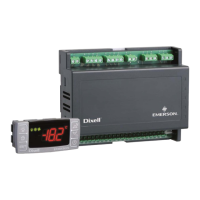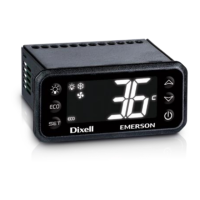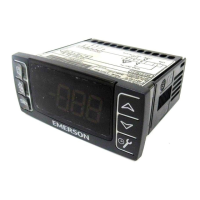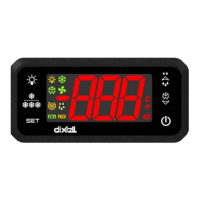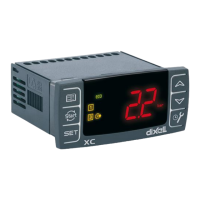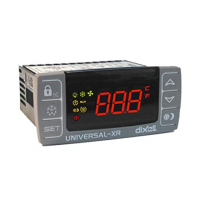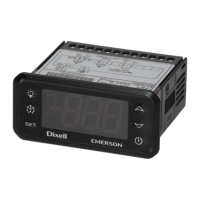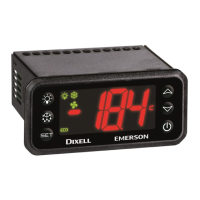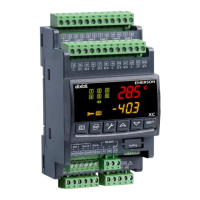1592023130 XM670K_XM679K GB r4.2 26.06.2017.docx XM670K - XM679K 7/10
SOA Fixed value for analog output: (0 ÷ 100%) value for the output if trA=UAL;
SdP Default value for Dew point: (-55,0÷50,0°C; -67÷122°F) default value of dew point used when
there is no supervising system (XWEB5000). Used only when trA=AC;
ASr Dew-point offset (trA=AC) / Differential for modulating fan regulation (trA=rEG): (-25.5°C ÷
25.5°C) (-45°F ÷ 45°F);
PbA Differential for anti-sweat heaters: (0.1°C ÷ 25.5°C) (1°F ÷ 45°F)
AMi Minimum value for analog output: (0÷AMA)
AMA Maximum value for analog output: (Ami ÷ 100)
AMt Anti-sweat heaters cycle period (trA=AC)/ Time with fan at maximum speed (trA=rEG):
(0÷255 s) when the fan starts, during this time the fan is at maximum speed;
ALARMS
rAL Probe for temperature alarm: (nP - P1 - P2 - P3 - P4 - P5 – tEr) it selects the probe used to
signal alarm temperature
ALC Temperature alarm configuration: rE = High and Low alarms related to Set Point; Ab = High
and low alarms related to the absolute temperature.
ALU High temperature alarm setting: (ALC= rE, 0
50°C or 90°F / ALC= Ab, ALL
150°C or 302°F)
when this temperature is reached and after the ALd delay time the HA alarm is enabled.
ALL Low temperature alarm setting: (ALC = rE , 0
50 °C or 90°F / ALC = Ab , - 55°C or - 67°F
ALU) when this temperature is reached and after the ALd delay time, the LA alarm is enabled.
AHy Differential for temperature alarm: (0.1°C ÷ 25.5°C / 1°F ÷ 45°F) Intervention differential for
recovery of temperature alarm;
ALd Temperature alarm delay: (0÷255 min) time interval between the detection of an alarm condition
and the corresponding alarm signalling.
dLU High temperature alarm (defrost probe): (ALC= rE, 0
50°C or 90°F / ALC= Ab, ALL
150°C
or 302°F) when this temperature is reached and after the ddA delay time the HAd alarm is
enabled.
dLL Low temperature alarm (defrost probe): (ALC = rE , 0
50 °C or 90°F / ALC = Ab , - 55°C or
- 67°F
ALU) when this temperature is reached and after the ALd delay time, the LAd alarm is
enabled.
dAH Differential for temperature alarm (defrost probe): (0.1°C ÷ 25.5°C / 1°F ÷ 45°F) Intervention
differential for recovery of temperature alarm;
ddA Temperature alarm delay (defrost probe): (0÷255 min) time interval between the detection of
an alarm condition and the corresponding alarm signalling.
FLU High temperature alarm (defrost probe): (ALC= rE, 0
50°C or 90°F / ALC= Ab, ALL
150°C
or 302°F) when this temperature is reached and after the FAd delay time the HAF alarm is
enabled.
FLL Low temperature alarm (defrost probe): (ALC = rE , 0
50 °C or 90°F / ALC = Ab , - 55°C or
- 67°F
ALU) when this temperature is reached and after the FAd delay time, the LAF alarm is
enabled.
FAH Differential for temperature alarm (defrost probe): (0.1°C ÷ 25.5°C / 1°F ÷ 45°F) Intervention
differential for recovery of temperature alarm;
FAd Temperature alarm delay (defrost probe): (0÷255 min) time interval between the detection of
an alarm condition and the corresponding alarm signalling.
dAO Delay of temperature alarm at start-up: (0min÷23h 50min) time interval between the detection
of the temperature alarm condition after the instrument power on and the alarm signalling.
EdA Alarm delay at the end of defrost: (0
255 min) Time interval between the detection of the
temperature alarm condition at the end of defrost and the alarm signalling.
dot Temperature alarm exclusion after door open:
Sti Stop regulation interval (Only XM679K): (0.0÷24.0 hours: tens of minutes) after regulating
continuously for Sti time, the valve closes for Std time in order to prevent ice creation.
Std Stop duration (Only XM679K): (0÷60 min.) it defines stop regulation time after Sti.
nMS Maximum number of regulation pauses (nu, 1÷255)
OPTIONAL OUTPUT (AnOUT) if present
OA6 Sixth relay configuration (CPr-dEF-Fan-ALr-LiG-AUS-db-OnF): CPr= relay works as a
compressor or solenoid valve relay; dEF= relay works as defrost relay; Fan= relay works as a
Fan relay; ALr= activation with alarm conditions; LiG= light activation; AUS= auxiliary relay, it
can be switched ON/OFF also by key; db= dead band regulation (not compatible with CrE=y);
OnF= ON/OFF functioning;
CoM Type of functioning modulating output:
For models with PWM / O.C. output PM5= PWM 50Hz; PM6= PWM 60Hz;
OA7= not set it;
For models with 4÷20mA / 0÷10V output Cur= 4÷20mA current output; tEn=
0÷10V voltage output;
AOP Alarm relay polarity: cL= normally closed; oP= normally opened;
iAU Auxiliary output is unrelated to ON/OFF device status: n= if the instrument is switched off
also the auxiliary output is switched off; Y= the auxiliary output state is unrelated to the ON/OFF
device status
DIGITAL INPUTS
i1P Digital input 1 polarity: (cL – oP) CL: the digital input is activated by closing the contact; OP:
the digital input is activated by opening the contact.
i1F Digital input 1 function: (EAL – bAL – PAL – dor – dEF – AUS – LiG – OnF – Htr – FHU – ES
– Hdy) EAL= external alarm; bAL= serious external alarm; PAL= pressure switch activation; dor=
door open; dEF= defrost activation; AUS= auxiliary activation; LiG= light activation; OnF= switch
on/off the instrument; Htr= change type of action ; FHU= not used; ES= activate energy saving;
Hdy= activate holiday function;
d1d Time interval/delay for digital input alarm: (0
255 min.) Time interval to calculate the number
of the pressure switch activation when i1F=PAL. If I1F=EAL or bAL (external alarms), “d1d”
parameter defines the time delay between the detection and the successive signalling of the
alarm. If i1F=dor this is the delay to activate door open alarm
i2P Digital input 2 polarity: (cL – oP) CL : the digital input is activated by closing the contact; OP:
the digital input is activated by opening the contact.
i2F Digital input 2 function: (EAL – bAL – PAL – dor – dEF – AUS – LiG – OnF – Htr – FHU – ES
– Hdy) EAL= external alarm; bAL= serious external alarm; PAL= pressure switch activation; dor=
door open; dEF= defrost activation; AUS= auxiliary activation; LiG= light activation; OnF= switch
on/off the instrument; Htr= change type of action ; FHU= not used; ES= activate energy saving;
Hdy= activate holiday function;
d2d Time interval/delay for digital input alarm: (0
255 min.) Time interval to calculate the number
of the pressure switch activation when i2F=PAL. If I2F=EAL or bAL (external alarms), “d2d”
parameter defines the time delay between the detection and the successive signalling of the
alarm. If i2F=dor this is the delay to activate door open alarm
i3P Digital input 3 polarity: (cL – oP) CL : the digital input is activated by closing the contact; OP:
the digital input is activated by opening the contact.
i3F Digital input 3 function: (EAL – bAL – PAL – dor – dEF – AUS – LiG – OnF – Htr – FHU – ES
– Hdy) EAL= external alarm; bAL= serious external alarm; PAL= pressure switch activation; dor=
door open; dEF= defrost activation; AUS= auxiliary activation; LiG= light activation; OnF= switch
on/off the instrument; Htr= change type of action ; FHU= not used; ES= activate energy saving;
Hdy= activate holiday function;
d3d Time interval/delay for digital input alarm: (0
255 min.) Time interval to calculate the number
of the pressure switch activation when i3F=PAL. If i3F=EAL or bAL (external alarms), “d3d”
parameter defines the time delay between the detection and the successive signalling of the
alarm. If i3F=dor this is the delay to activate door open alarm
nPS Pressure switch number: (0
15) Number of activation of the pressure switch, during the “d#d”
interval, before signalling the alarm event (I2F= PAL). If the nPS activation in the did time is
reached, switch off and on the instrument to restart normal regulation.
odc Compressor and fan status when open door: no = normal; Fan = Fan OFF; CPr =
Compressor OFF; F_C = Compressor and fan OFF.
rrd Outputs restart after doA alarm: no = outputs not affected by the doA alarm; yES = outputs
restart with the doA alarm;
RTC SUBMENU (if present)
CbP Clock Presence (n÷y): it permits to disable or enable the clock;
Hur Current hour (0 ÷ 23 h)
Min Current minute (0 ÷ 59min)
dAY Current day (Sun ÷ SAt)
Hd1 First weekly holiday (Sun ÷ nu) Set the first day of the week which follows the holiday times.
Hd2 Second weekly holiday (Sun ÷ nu) Set the second day of the week which follows the holiday
times.
Hd3 Third weekly holiday (Sun ÷ nu) Set the third day of the week which follows the holiday times.
ILE Energy Saving cycle start during workdays: (0 ÷ 23h 50 min.) During the Energy Saving cycle
the set point is increased by the value in HES so that the operation set point is SET + HES.
dLE Energy Saving cycle length during workdays: (0 ÷ 24h 00 min.) Sets the duration of the
Energy Saving cycle on workdays.
ISE Energy Saving cycle start on holidays. (0 ÷ 23h 50 min.)
dSE Energy Saving cycle length on holidays (0 ÷ 24h 00 min.)
HES Temperature increase during the Energy Saving cycle (-30÷30°C / -54÷54°F) sets the
increasing value of the set point during the Energy Saving cycle.
Ld1÷Ld6 Workday defrost start (0 ÷ 23h 50 min.) These parameters set the beginning of the 6
programmable defrost cycles during workdays. Ex. When Ld2 = 12.4 the second defrost starts at
12.40 during workdays.
Sd1÷Sd6 Holiday defrost start (0 ÷ 23h 50 min.) These parameters set the beginning of the 6
programmable defrost cycles on holidays. Ex. When Sd2 = 3.4 the second defrost starts at 3.40
on holidays.
ENERGY SAVING
ESP Energy saving probe selection: (nP - P1 - P2 - P3 - P4 - P5 – tEr).
HES Temperature increase during the Energy Saving cycle : (-30÷30°C / -54÷54°F) sets the
increasing value of the set point during the Energy Saving cycle.
PEL Energy saving activation when light is switched off: (n÷Y) n= function disabled; Y= energy
saving is actived when the light is switched off and vice versa;
LAN MANAGEMENT
LMd Desfrost synchronisation: y= the section send a command to start defrost to oher controllers,
n= the section don’t send a global defrost command
dEM Type of end defrost: n= the of the LAN defrost are indipendent; y= the end of the defrost are
synchronisated;
LSP L.A.N. set-point synchronisation: y= the section set-point, when modified, is updated to the
same value on all the other sections; n= the set-point value is modified only in the local section
LdS L.A.N. display synchronisation: y= the value displayed by the section is sent to all the other
sections; n= the set-point value is modified only in the local section
LOF L.A.N. On/Off synchronisation this parameter states if the On/Off command of the section will
act on all the other ones too: y= the On/Off command is sent to all the other sections; n= the
On/Off command acts only in the local section
LLi L.A.N. light synchronisation this parameter states if the light command of the section will act
on all the other ones too: y= the light command is sent to all the other sections; n= the light
command acts only in the local section
LAU L.A.N. AUX output synchronisation this parameter states if the AUX command of the section
will act on all the other ones too: y= the light command is sent to all the other sections; n= the
light command acts only in the local section
LES L.A.N. energy saving synchronisation this parameter states if the energy saving command of
the section will act on all the other ones too: y= the Energy Saving command is sent to all the
other sections; n= the Energy Saving command acts only in the local section
LSd Remote probe display: this parameter states if the section has to display the local probe value
or the value coming from another section: y= the displayed value is the one coming from another
section (which has parameter LdS = y); n= the displayed value is the local probe one.
LPP Remote pressure probe: n= the value of pressure probe is read from local probe; Y= the value
of pressure probe is sent via LAN;
StM Solenoid activation via LAN: n= not used; Y= a generic cooling requests from LAN activate the
solenoid valve connected to compressor relay;
PROBE CONFIGURATION
P1C Probe 1 configuration: (nP – Ptc – ntc – PtM) nP= not present; PtC= Ptc; ntc= NTC; PtM=
Pt1000;
Ot Probe 1 calibration: (-12.0
21°F) allows to adjust possible offset of the thermostat
probe.
P2C Probe 2 configuration: (nP – Ptc – ntc – PtM) nP= not present; PtC= Ptc; ntc = NTC; PtM=
Pt1000;
OE Probe 2 calibration: (-12.0
21°F) allows to adjust possible offsets of the evaporator
probe.
P3C Probe 3 configuration: (nP – Ptc – ntc – PtM) nP= not present; PtC= Ptc; ntc = NTC; PtM=
Pt1000;
o3 Probe 3 calibration: (-12.0
21°F) allows to adjust possible offset of the probe 3.
P4C Probe 4 configuration: (nP – Ptc – ntc – PtM) nP= not present; PtC= Ptc; ntc = NTC; PtM=
Pt1000;
o4 Probe 4 calibration: (-12.0
21°F) allows to adjust possible offset of the probe 4.
P5C Probe 5 configuration: (nP – Ptc – ntc – PtM – 420 – 5Vr) nP= not present; PtM= Pt1000; 420=
4÷ 20mA; 5Vr= 0÷5V ratiometric; (Only XM679K)
o5 Probe 5 calibration: (-12.0
21°F) allows to adjust possible offset of the probe 5.
(Only XM679K)
P6C Probe 6 configuration: (nP – Ptc – ntc – PtM) nP= not present; PtC= Ptc; ntc = NTC; PtM=
Pt1000; (Only XM679K)
o6 Probe 6 calibration: (-12.0
21°F) allows to adjust possible offset of the probe 6.
(Only XM679K)
SERVICE – READ ONLY
CLt Coling time percentage: it shows the effective cooling time calculated by XM600 during
regulation;
tMd Time to next defrost: it shows time before the next defrost if interval defrost is selected;
LSn L.A.N. section number (1 ÷ 8) Shows the number of sections available in the L.A.N.
Lan L.A.N. serial address (1 ÷ LSn) Identifies the instrument address inside local network of
multiplexed cabinet controller.
Adr RS485 serial address (1÷247): Identifies the instrument address when connected to a ModBUS
compatible monitoring system.

